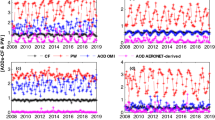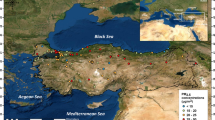Abstract
A regional chemical transport model assimilated with daily mean satellite and ground based Aerosol Optical Depth (AOD) observations is used to produce three dimensional distributions of aerosols throughout Europe for the year 2005. In this paper, the AOD measurements of the Ozone Monitoring Instrument (OMI) are assimilated with Polyphemus model. In order to overcome missing satellite data, a methodology for pre-processing AOD based on Neural Network (NN) is proposed. The aerosol forecasts involve two-phase process assimilation, and then a feedback correction process. During the assimilation phase, the total column AOD is estimated from the model aerosol fields. The model state is then adjusted to improve the agreement between the simulated AOD and satellite retrievals of AOD. The results show that the assimilation of AOD observations significantly improves the forecast for total mass. The errors on aerosol chemical composition are reduced and are sometimes vanished by the assimilation procedure and NN preprocessing, which shows a big contribution to the assimilation process.
Access this chapter
Tax calculation will be finalised at checkout
Purchases are for personal use only
Preview
Unable to display preview. Download preview PDF.
Similar content being viewed by others
References
Ramanathan, V., Crutzen, P.J., Kiehl, J.T., Rosenfeld, D.: Atmosphere – Aerosols, climate, and the hydrological cycle. Science 294(5549), 2119–2124 (2002)
Diner, D.J., et al.: Level 2 Aerosol Retrieval Algorithm Theoretical Basis. Jet Propulsion Lab., Pasadena, CA, JPL Tech. Doc. D-11400 (2008)
Wen, G., Tsay, S.C., Cahalan, R.F., Oreopoulos, L.: Path Radiance Technique for Retrieving Aerosol Optical Thickness over Land. J. Geophys. Res. 104, 31321–31332 (1999)
Han, B., Braverman, A., Vucetic, S., Obradovic, Z.: Construction of an Accurate Geospatial Predictor by Fusion of Global and Local Models. In: 8th Int’l Conf. Information Fusion, Philadelphia, PA (2005)
Torres, O., Decae, R., Veefkind, J.P., de Leeuw, G.: OMI Aerosol Retrieval Algorithm. OMI Algorithm Theoretical Basis Document: Clouds, Aerosols, and Surface UV Irradiance 3(2) (2002)
Ali, A., Amin, S.E., Ramadan, H.H., Tolba, M.F.: Ozone monitoring instrument aerosol products: Algorithm modeling and validation with ground based measurements over Europe. In: The 2011 International Conference on Computer Engineering & Systems (ICCES 2011), Cairo, Egypt (2011)
Ali, A., Amin, S.E., Ramadan, H.H., Tolba, M.F.: Ozone Monitoring Instrument aerosol products: a comparison study with ground-based airborne sun photometer measurements over Europe. Int. J. Remote Sens. 33(20), 6321–6341 (2012)
Boutahar, J., Lacour, S., Mallet, V., Quelo, D., Roustan, Y., Sportisse, B.: Development and validation of a fully modular platform for numerical modelling of air pollution: POLAIR. Int. J. Environ. Pollut. 22(1/2), 17–28 (2004)
Debry, E., Fahey, K., Sartelet, K., Sportisse, B., Tombette, M.: Technical note: A new SIze REsolved Aerosol Model, Atmos. Chem. Phys. 7, 1537–1547 (2007)
Mallet, V., Quelo: Technical Note: The air quality modeling system Polyphemus. Atmos. Chem. Phys. 7, 5479–5487 (2007)
Sartelet, K.N., Debry, E., Fahey, K.M., Roustan, Y., Tombette, M., Sportisse, B.: Simulation of aerosols and gas-phase species over Europe with the Polyphemus system. Part I: model-to-data comparison for 2001. Atmos. Environ. 29, 6116–6131 (2007)
Tombette, M., Sportisse, B.: Aerosol modeling at a regional scale: Model-to-data comparison and sensitivity analysis over Greater Paris. Atmos. Environ. 41, 6941–6950 (2007)
Hollingsworth, A., Lonnberg, P.: The statistical structure of short-range forecast errors as de-termined from radiosonde data. Part I: the wind field. Tellus 38A, 111–136 (1986)
Dunlea, E.J., Herndon, S.C.: Evaluation of nitrogen dioxide chemiluminescence monitors in a polluted urban environment. Atmos. Chem. Phys. 7, 2691–2704 (2007)
Debry, E., Fahey, K., Sartelet, K., Sportisse, B., Tombette, M.: Technical note: A new SIze REsolved Aerosol Model. Atmos. Chem. Phys. 7, 1537–1547 (2007)
Schell, B., Ackermann, I.J., Hass, H., Binkowski, F.S., Ebel, A.: Modeling the formation of secondary organic aerosol within a comprehensive air quality model system. Journal of Geophysical Research 106, 28275–28293 (2001)
Boylan, J.W.: PM and light extinction model performance metrics, goals, and criteria for three-dimensional air quality models. Atmos. Environ. 40, 4946–4959 (2006)
Huneeus, N.: Assimilation variationnelle d’observations satellitaires dans un mod‘ele atmosphérique d’aérosols, Ph.D. thesis, Université des Sciences et Technologies de Lille (2007)
Wu, D., Hartman, A., Ward, N., Eisen, J.A.: An Automated Phylogenetic Tree-Based Small Subunit rRNA Taxonomy and Alignment Pipeline (STAP). PLoS ONE 3(7), e2566 (2008), doi:10.1371
Author information
Authors and Affiliations
Editor information
Editors and Affiliations
Rights and permissions
Copyright information
© 2012 Springer-Verlag Berlin Heidelberg
About this paper
Cite this paper
Ali, A., Amin, S.E., Ramadan, H.H., Tolba, M.F. (2012). Integration of Neural Network Preprocessing Model for OMI Aerosol Optical Depth Data Assimilation. In: Hassanien, A.E., Salem, AB.M., Ramadan, R., Kim, Th. (eds) Advanced Machine Learning Technologies and Applications. AMLTA 2012. Communications in Computer and Information Science, vol 322. Springer, Berlin, Heidelberg. https://doi.org/10.1007/978-3-642-35326-0_49
Download citation
DOI: https://doi.org/10.1007/978-3-642-35326-0_49
Publisher Name: Springer, Berlin, Heidelberg
Print ISBN: 978-3-642-35325-3
Online ISBN: 978-3-642-35326-0
eBook Packages: Computer ScienceComputer Science (R0)




